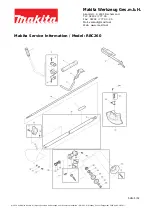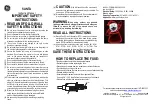
MOTION SENSOR
HKZW-MS02-V1.0
Operating
Manual
Thank you for your support!
Please read the user manual carefully before operat-
ing the device.
Please keep the user manual for future reference.
Product Introduction
The motion sensor is a Z-Wave based sensor. It will
send radio signals to associated Z-Wave devices
within its own Z-Wave network when it detects IR
changes.
It is allowed to be installed on a shelf, in the corner of
your room, anywhere on the wall and even at the
ceiling.
Features list:
1) Z-Wave series 500 protocol
2) Supports security 0 and security 2 protected mode
with AES-128 encryption
3) Tamper alarm by vibration sensor
4) Up to 1 year battery life
5) Low battery alert
6) Supports firmware OTA (over the air update)
GENERAL INFORMATION
Product Layout
Specifications
Power supply:
3V: 1x CR123A or USB
Standby current:
about 20µA
Working current:
about 55mA
Recommended instal-
lation height:
2m ~ 4m
Storage environment:
-10 ~ 50 °C 0% ~ 80% rH
Operating temperature: 0 ~ 40 °C
Radio protocol:
Z-Wave
Radio frequencies:
868.42 MHz (EU)
908.42 MHz (US)
921.42 MHz (AU)
Range:
More than 100m outdoors
About 30m indoors (depending
on building materials)
Dimension:
50mm (Ø)
INSTALLATION
1) Turn the cover counter-clockwise and open it.
2) Remove the battery blocker.
3)
Add the device (see “Adding/removing the device”).
4) Close the cover and turn it clockwise.
5) Place the sensor to anywhere you want.
The sensor's motion detection area is shown as below.
The actual range of the sensor can be influenced by
environment conditions. Should false motion alarms be
reported, check for any moving objects within the sen-
sor's detection area, such as trees blowing in the wind,
cars passing by, windmills, pets, etc.
False motion alarms may be caused by moving masses
of air and heat as well. If the device keeps on reporting
false alarms, despite eliminating all of the above-
mentioned factors, install the device in another place.
Approximate detection area:
ADDING/REMOVING THE DEVICE
Include as a non-secure device:
1) Open the cover.
2) Place the device within direct range of your Z-Wave
controller.
3) Set the Z-Wave controller into the Add (inclusion)
mode (see controller operating manual).
4) Click the Z-Button once or triple click the Z-button
quickly, the LED indicator should blink fast.
5) Wait for the adding process to end.
6) A successful adding will be confirmed by the Z-Wave
controller's message.
Include as a secure device (S0 or S2):
1) Open the cover.
2) Place the device within the direct range of your Z
Wave controller.
3) Set the Z-Wave controller into the security Add (in-
clusion) mode (see controller operating manual).
4) Press and hold the Z-Button for more than 3 seconds
and then release, the LED indicator should blink fast.
5) Wait for the adding process to end.
6) Successful adding will be confirmed by the Z-Wave
controller's message.
TIP:
If you want your motion sensor to be a
secure device and use secure/encrypted
messages to communicate in the Z-Wave
network, then a security enabled Z-Wave
controller is required.
Removing:
1) Open the cover.
2) Place the device within the direct range of your Z
Wave controller.
3) Set the Z-Wave controller into the Remove mode
(see controller operating manual).
4) Triple click the Z-Button quickly, the LED indicator
should blink fast.
5) Wait for the removing process to end.
6) Successful removing will be confirmed by the Z-Wave
controller's message.
ASSOCIATION
Associations allow the motion sensor to control other
Z-Wave devices such as Smart Switch, Smart Dimmer,
etc. It supports two association groups and can associ-
ate maximum 5 nodes in each group.
Group 1 reports the motion detection and battery level.
Group 2 is assigned to send BASIC SET command.
WAKE UP INTERVAL
Available settings:
0 ~ 2678400
Default setting:
0
This defines a time period after which the motion sensor
sends a wake up notification command to communicate
with the assigned device, update parameters, update
software, detects battery level, etc.
A wake up interval set between 0 and 59 disables the
sending of the wake up notification command. In such
a configuration you can manually wake the device up
by pressing the Z-Button.
NOTE:
The step of the wake up interval
is 60 seconds. This means the motion
sensor will send a wake up notification
command after a time that is a multiple of
60 seconds. Setting examples:
0 ~ 59 = 0 seconds
, the device will not
wake up by itself.
60 ~ 119 = 60 seconds
, the device will
wake up every 60 seconds.
RESETTING
The reset procedure clears the motion sensor's
memory, including Z-Wave network controller infor-
mation. To reset the motion sensor:
1) Power on the device.
2) Press and hold the Z-Button for more than 20
seconds.
3) After holding for 20 seconds, the LED indicator will
keep on for 2 seconds, which means the reset is
complete.
4) The reset feature works only when the device has
been included into a Z-Wave network.
NOTE:
Use this procedure only in the
event that the network primary controller
is missing or otherwise inoperable.
ADVANCED CONFIGURATION
The motion sensor offers a wide variety of advanced
configuration settings. The parameters below can be
accessed from main controllers configuration inter-
face (see controller operating manual).
Parameter No. 12 M
otion sensor’s sensitivity
The higher the value, the more sensitive the PIR
sensor is.
0 - Disabled motion detection
Available settings:
0 ~ 8
Default setting:
8
Parameter size:
1 [byte]
Parameter No. 14 Enable/disable BASIC SET
command
The motion sensor can send a BASIC SET command
to nodes associated with group 2 when motion is
triggered.
0 - Disabled
1 - Enabled
Default setting:
0
Parameter size:
1 [byte]
Parameter No. 15 Value of the BASIC SET
The motion sensor can reverse its value of BASIC
SET when motion is triggered.
0 - Send BASIC SET VALUE = 255 to nodes associ-
ated with group 2 when motion alarm is triggered.
Send BASIC SET VALUE = 0 to nodes associated
with group 2 when motion alarm is canceled.
1 - Send BASIC SET VALUE = 0 to nodes associated
with group 2 when motion alarm is triggered.































